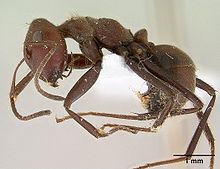Camponotus saundersi
| Camponotus saundersi | |
|---|---|
 |
|
| Scientific classification | |
| Kingdom: | Animalia |
| Phylum: | Arthropoda |
| Class: | Insecta |
| Order: | Hymenoptera |
| Family: | Formicidae |
| Genus: | Camponotus |
| Species: | C. saundersi |
| Binomial name | |
|
Camponotus saundersi Emery, 1889 |
|
Camponotus saundersi is a species of ant found in Malaysia and Brunei, belonging to the genus of Carpenter ants. Workers can explode suicidally and aggressively as an ultimate act of defense, an ability it has in common with several other species in this genus and a few other insects. The ant has an enormously enlarged mandibular (jaw) gland, many times the size of a normal ant, which produces defense adhesive secretions.
Its defensive behaviours include self-destruction by autothysis, a term coined by Maschwitz and Maschwitz (1974). Two oversized, poison-filled mandibular glands run the entire length of the ant's body. When combat takes a turn for the worse, the worker ant violently contracts its abdominal muscles to rupture its gaster at the intersegmental fold, which also bursts the mandibular glands, thereby spraying a sticky secretion in all directions from the anterior region of its head. The glue, which also has corrosive properties and functions as a chemical irritant, can entangle and immobilize all nearby victims.
Direct observation by Jones (2004) found that C. saundersi adhesive secretions range from bright white at the end of the wet season to cream or pale yellow in the dry season and start of the wet season. These variations in coloration represent a shift in internal pH, likely due to seasonal changes in diet.
Autothysis in C. saundersi is common during territorial battles with other ant species or groups. Territorial weaver ants (Oecophylla smaragdina) are known to stalk and attack C. saundersi for territory as well as for predation. Self-sacrifice of C. saundersi workers is likely to help the colony as a whole by ensuring that the colony retains its foraging territory. Therefore, such behavior would continue within a population given that the behavior was already genetically present within the majority of workers.
...
Wikipedia
